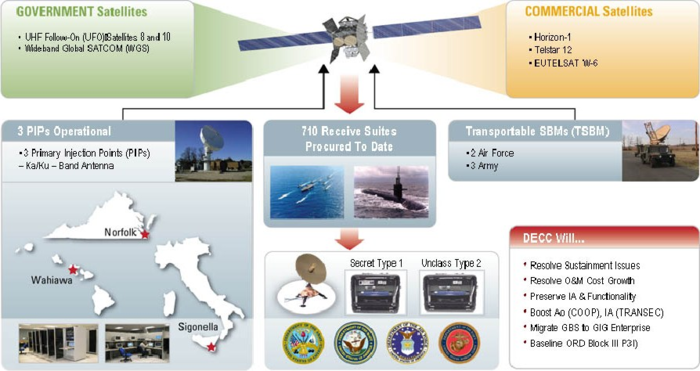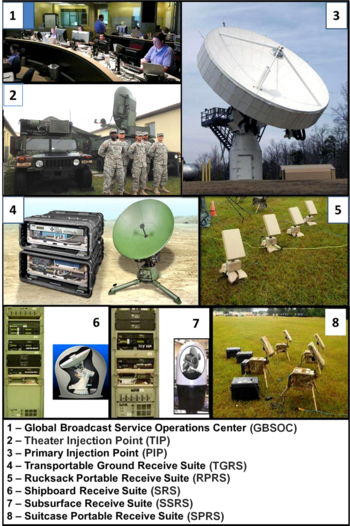196:, digital maps, satellite imagery, and much more-- using net-centric prioritized delivery based on unit mission reception priority profiles. The SBM is the primary broadcast content site through which information and products are transmitted once to the satellite via PIPs and teleport gateways and received by multiple RBMs saving valuable bandwidth and time. Through use of the TIP, GBS is capable of injecting information directly from within a
154:
24:
144:
The GBS acquisition strategy was initially conceived as a three-phase program based on an evolutionary system design supported by commercially available technology. Technical problems with transmit suite software, transportable and fixed receive suite design, and subsequent program delays led to a
79:
161:
In 2016, the GBS program manager developed the GBS Phase-IV capability that included an upgraded
Transportable Ground Receive Suite (TGRS), development of Suitcase and Rucksack Portable Receive Suites (SPRS and RPRS), and integration of the new
181:. The SBM, Primary and Theater Injection Points (PIP and TIP), and DoD Teleport Gateways will then generate IP-based broadcasts for transmission over UFO and WGS satellites to be received by units equipped with RBMs, with up to 45
149:
decision to defer a small subset of capabilities, field the system with non-deferred capabilities, and then incrementally field upgrades until all the operational requirement thresholds were met and IOC declared.
47:
223:-sponsored homeland defense organizations worldwide." The U.S. Army has stated that GBS "provides critical situational awareness, decreases decision times and increases combat agility."
330:
406:
174:
GBS consists of a SBM, co-located with DISA's DECC, and a variety of
Receive Broadcast Managers (RBMs) owned and operated by the military services and other government agencies.
390:, Office of the Secretary of Defense, Office of the Directory, Operational Test & Evaluation, U.S. Department of Defense; dated 2016; last accessed 12 November 2017
371:, Office of the Secretary of Defense, Office of the Directory, Operational Test & Evaluation, U.S. Department of Defense; dated 2002; last accessed 12 November 2017
242:
185:, that is designed to provide users with a broad range of bandwidth-intensive products without loading traditional command and communication networks.
102:(IOC) for GBS Phase II, Block II was declared in October 2008. In 2014, the GBS Satellite Broadcast Manager (SBM) architecture transitioned to the
46:(DoD) and its deployed and garrisoned units worldwide. Information may include video and digital data. GBS has become a critical piece of the DoD's
247:
305:, U.S. Army's Program Executive Office for Command, Control, Communications-Tactical, last updated 6 March 2017, last accessed 12 November 2017
383:
146:
364:
327:
178:
103:
252:
153:
346:
220:
99:
115:
82:
The United States
Department of Defense's Global Broadcast Service general concept of operations, circa January 2010
212:
130:
43:
298:
237:
134:
129:
was the dominant commercial model for the GBS architecture and the program followed that model using commercial
51:
204:
193:
55:
95:
39:
197:
126:
232:
216:
208:
380:
23:
361:
189:
138:
141:(IP)-based equipment, GBS upgraded as well using the same commercially available equipment.
347:
Joint Pub 6-02, Joint
Doctrine for Employment of Operational-Tactical C4 Systems, 01 OCT 96
387:
368:
334:
302:
87:
400:
107:
119:
78:
166:(DVB-S2) waveform that should provide more efficient use of available bandwidth.
219:, and U.S. Air Force ground sites, shipboard and subsurface platforms and at
86:
Beginning in 1998, GBS began broadcasting via communication payloads on two
207:, "GBS provides service to 1000+ GBS receive suites deployed worldwide at
133:
equipment with customized government application software. As commercial
38:) is a broadcast service rapidly transferring information, which may be
188:
Deployed users can subscribe to large-volume national products --such as
111:
63:
267:
262:
257:
91:
295:
337:, U.S. Air Force, dated 22 March 2017, last accessed 12 November 2017
163:
106:'s (DISA) Defense Enterprise Computing Center (DECC) via two sites,
69:
High data rates to very small, low-cost user receive-only terminals
182:
177:
The DECC connects to a variety of national sources through the
381:
FY16 Air Force
Programs, Global Broadcast Service (GBS) System
152:
22:
164:
323:
321:
319:
317:
315:
313:
311:
362:Air Force Programs, Global Broadcast Service (GBS)
243:Transformational Satellite Communications System
357:
355:
48:intelligence, surveillance and reconnaissance
8:
407:Military communications of the United States
94:augmented satellites and more recently all
291:
289:
287:
285:
283:
77:
279:
248:Defense Satellite Communications System
200:under the theater commander's control.
157:GBS's primary ground and sea components
122:and remain in operations there today.
98:(WGS) satellites (via Ka-band only).
258:Military Strategic and Tactical Relay
7:
147:Joint Requirements Oversight Council
18:U.S. defense communications project
179:Defense Information System Network
104:Defense Information Systems Agency
14:
253:Advanced Extremely High Frequency
125:At the onset of the GBS program,
50:architecture. An advancement in
100:Initial Operational Capability
88:Ultra High Frequency Follow-On
1:
296:Satellite Communications: GBS
135:satellite Internet services
127:direct broadcast television
423:
386:November 13, 2017, at the
367:November 13, 2017, at the
333:November 13, 2017, at the
301:November 13, 2017, at the
131:Asynchronous Transfer Mode
44:U.S. Department of Defense
238:Communications protection
328:Global Broadcast Service
194:unmanned aerial vehicles
52:satellite communications
32:Global Broadcast Service
56:military communications
158:
96:Wideband Global SATCOM
83:
27:
349:. Pages IV-4 to IV-5.
221:U.S. Northern Command
198:theater of operations
156:
81:
66:to many users at once
26:
54:, GBS fills two key
233:Telecommunications
159:
84:
28:
203:According to the
190:full motion video
139:Internet Protocol
414:
391:
378:
372:
359:
350:
344:
338:
325:
306:
293:
422:
421:
417:
416:
415:
413:
412:
411:
397:
396:
395:
394:
388:Wayback Machine
379:
375:
369:Wayback Machine
360:
353:
345:
341:
335:Wayback Machine
326:
309:
303:Wayback Machine
294:
281:
276:
229:
172:
76:
19:
12:
11:
5:
420:
418:
410:
409:
399:
398:
393:
392:
373:
351:
339:
307:
278:
277:
275:
272:
271:
270:
265:
260:
255:
250:
245:
240:
235:
228:
225:
205:U.S. Air Force
171:
168:
75:
72:
71:
70:
67:
58:requirements:
17:
13:
10:
9:
6:
4:
3:
2:
419:
408:
405:
404:
402:
389:
385:
382:
377:
374:
370:
366:
363:
358:
356:
352:
348:
343:
340:
336:
332:
329:
324:
322:
320:
318:
316:
314:
312:
308:
304:
300:
297:
292:
290:
288:
286:
284:
280:
273:
269:
266:
264:
261:
259:
256:
254:
251:
249:
246:
244:
241:
239:
236:
234:
231:
230:
226:
224:
222:
218:
214:
210:
206:
201:
199:
195:
191:
186:
184:
180:
175:
169:
167:
165:
155:
151:
148:
142:
140:
136:
132:
128:
123:
121:
117:
116:Mechanicsburg
113:
109:
108:Oklahoma City
105:
101:
97:
93:
89:
80:
73:
68:
65:
61:
60:
59:
57:
53:
49:
45:
41:
37:
33:
25:
21:
16:
376:
342:
213:U.S. Marines
202:
187:
176:
173:
160:
143:
124:
120:Pennsylvania
85:
35:
31:
29:
20:
15:
274:References
170:Operations
64:data rates
42:, for the
40:classified
217:U.S. Navy
209:U.S. Army
137:moved to
401:Category
384:Archived
365:Archived
331:Archived
299:Archived
227:See also
112:Oklahoma
268:SIPRNet
263:NIPRNet
92:Ka-band
74:History
90:(UFO)
192:from
62:High
183:Mbps
114:and
30:The
36:GBS
403::
354:^
310:^
282:^
215:,
211:,
118:,
110:,
34:(
Text is available under the Creative Commons Attribution-ShareAlike License. Additional terms may apply.


